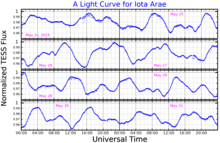| Observation data Epoch J2000 Equinox J2000 | |
|---|---|
| Constellation | Ara |
| Right ascension | 17h 23m 16.07624s[1] |
| Declination | −47° 28′ 05.5057″[1] |
| Apparent magnitude (V) | 5.18 - 5.26[2] |
| Characteristics | |
| Spectral type | B2 IIIne[3] |
| U−B color index | −0.82[4] |
| B−V color index | −0.11[4] |
| R−I color index | −0.08 |
| Variable type | BE[2] |
| Astrometry | |
| Radial velocity (Rv) | −19[5] km/s |
| Proper motion (μ) | RA: −6.209[1] mas/yr Dec.: −17.699[1] mas/yr |
| Parallax (π) | 3.5613 ± 0.0904 mas[1] |
| Distance | 920 ± 20 ly (281 ± 7 pc) |
| Absolute magnitude (MV) | −2.06[6] |
| Details | |
| Mass | 8.3±0.4[7] M☉ |
| Radius | 6.3[1] R☉ |
| Luminosity | 10,864[8] L☉ |
| Surface gravity (log g) | 4.18[8] cgs |
| Temperature | 20,172[1] K |
| Rotational velocity (v sin i) | 340[8] km/s |
| Age | 30.0±7.4[7] Myr |
| Other designations | |
| Database references | |
| SIMBAD | data |
Iota Arae, Latinized from ι Arae, is the Bayer designation for a star in the southern constellation of Ara. It is 920 light-years (281 parsecs) from Earth, give or take a 20 light-year margin of error, and has an apparent visual magnitude of 5.2. Based upon the Bortle Dark-Sky Scale, this means the star is visible to the naked eye from suburban skies.
This is an evolved giant star with a stellar classification of B2 IIIne.[3] The 'e' notation indicates the spectrum displays emission lines, which means this is a Be star that is surrounded by hot, circumstellar gas. It is spinning rapidly with a projected rotational velocity of 340 km/s. The Doppler effect from this rotation is causing the absorption lines to widen and become nebulous, as indicated by the 'n' notation in the stellar class.

Iota Arae has around 8.3 times the mass of the Sun and is shining brightly with 10,864 times the Sun's luminosity. This energy is being radiated into space from the outer atmosphere at an effective temperature of 20,172 K, giving it the characteristic blue-white hue of a B-type star.[11] The General Catalog of Variable Stars classifies it as a BE variable star, ranging from visual magnitude 5.18 to 5.26 with a period of 13.36 hours.[2] In a study of the Hipparcos data, it was found to vary in brightness by 0.054 in magnitude with no clear period.[12]
- ^ a b c d e f g Cite error: The named reference
dr3was invoked but never defined (see the help page). - ^ a b c Cite error: The named reference
gcvswas invoked but never defined (see the help page). - ^ a b Cite error: The named reference
apj157_313was invoked but never defined (see the help page). - ^ a b Cite error: The named reference
aass61_387was invoked but never defined (see the help page). - ^ Cite error: The named reference
rgcrv1966was invoked but never defined (see the help page). - ^ Cite error: The named reference
Anderson2012was invoked but never defined (see the help page). - ^ a b Cite error: The named reference
mnras410_1_190was invoked but never defined (see the help page). - ^ a b c Cite error: The named reference
zorec2016was invoked but never defined (see the help page). - ^ Cite error: The named reference
SIMBADwas invoked but never defined (see the help page). - ^ Cite error: The named reference
MASTwas invoked but never defined (see the help page). - ^ Cite error: The named reference
csirowas invoked but never defined (see the help page). - ^ Cite error: The named reference
aaa507_2_11411201was invoked but never defined (see the help page).
